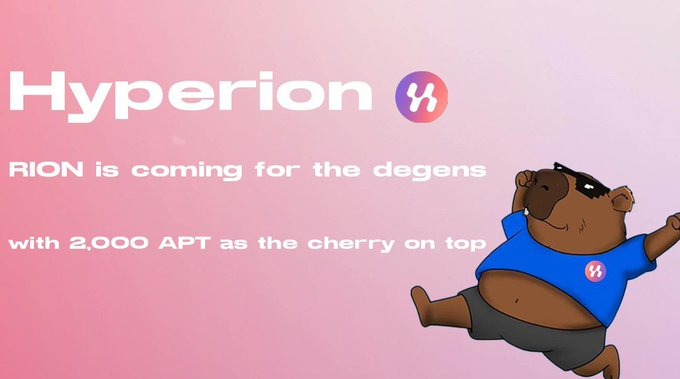Hyperion: The Core Engine Restructuring Liquidity in the Aptos Ecosystem
In June 2025, Hyperion Protocol, strategically invested by Aptos Labs and led by OKX Ventures, became the largest liquidity hub in the Aptos ecosystem with 38% TVL dominance ($102 million). The project aims to resolve on-chain trading’s core pain points: liquidity fragmentation across multiple DEXs causing high slippage (native AMM slippage reaches 0.8-1.5%), complex user operations, and unstable market-making returns. By integrating a four-layer architecture—trade aggregation engine, Concentrated Liquidity Market Making (CLMM), Dynamic Liquidity Market Making (DLMM), and Vault strategies—Hyperion enables “one-stop access to deep liquidity,” processing over $3 billion in cumulative trading volume with 120,000+ daily trades.

This Token Insights article explores how Hyperion integrates Aptos liquidity through aggregation and innovative market-making, covering its technical architecture, token economics, and ecosystem value.
Technical Architecture: Four-Layer Engine Driving Efficient Trading
Hyperion’s core strength is built atop Aptos’ Block-STM parallel execution engine, enhanced by four innovations:
-
Trade Aggregation Layer: Bridges liquidity from 7 major DEXs including LiquidSwap and Aries Market. Smart routing optimizes paths for large trades—slippage below 0.15% for swaps over $10,000.
-
CLMM Mechanism: LPs can concentrate liquidity in specific price ranges, reducing slippage by 70% compared to traditional AMMs, ideal for stablecoin and major token pairs.
-
DLMM Dynamic Model: Adjusts market-making ranges based on volatility algorithms, hedging impermanent loss, especially suited for volatile assets like APT and xBTC.
-
Vault Strategy: Users stake tokens into LP vaults managed by pro market-makers. Yield structure: 50% fee share + 30% $RION incentives + 20% strategy excess returns.
Thanks to Aptos’ base-layer optimizations, per-trade latency is under 0.3s and gas fees as low as $0.001. Developers can refer to JuCoin’s Aptos ecosystem guide for integration.
Token Economics & TGE Process
The $RION token underpins the ecosystem with three primary utilities:
-
Governance Voting: Determine fee distribution ratios and new asset listings
-
Protocol Incentives: 30% of trading fees rewarded in $RION to LPs
-
Gas Discounts: Holders of ≥1,000 $RION enjoy 50% gas fee discounts
Token Generation Event (TGE) Staging Plan:
-
July 16, 2025: Exclusive Bonding Curve sale on Binance Wallet (16:00–18:00 UTC+8), utilizing a unified curve for dynamic pricing favoring early participants
-
Q3 2025: Public sale and exchange listing, initial circulation includes 3% community airdrop + 25% liquidity incentives
-
Long-Term Vesting: Team & investor shares (20%) locked for 12 months for ecosystem stability
Ecosystem Partnerships & Growth Flywheel
Hyperion’s rapid rise is fueled by major backers:
-
OKX Ventures: Cross-chain bridge support for BTC/USDT
-
Aptos Labs: Integrates native assets (APT, tAPT) as base pairs
-
Maelstrom (Arthur Hayes Family Office): Injects institutional-grade vault strategies
Key development milestones:
-
Q3 2025: Launchpad activation with AI project NaviAI token launch; $RION staking (estimated 12–18% APY)
-
Q4 2025: Expansion to Sui network for Aptos-Sui cross-chain swaps
Liquidity Incentive Programs: 120,000 APT rewards for xBTC/APT pool; $40,000 prize pool for Bitget Wallet trading competition.
Competitive Landscape & Risk Alerts
Within Aptos, Hyperion leads with 38% TVL, ahead of LiquidSwap (29%) and Aries Market (18%). However, external challenges persist:
-
Technical Bottlenecks: Block-STM under high concurrency sees >5% transaction conflict rate—rollback mechanisms need refinement
-
Cross-Chain Competition: Solana’s Raydium V4 supports similar CLMM+aggregator functions
-
Regulatory Risk: U.S. SEC may classify $RION as a security, limiting U.S. user access to vaults
When trade aggregation eliminates liquidity silos and passive yield strategies hedge impermanent loss, decentralized trading truly breaks the ceiling of user experience. Hyperion’s breakout is not just a technical victory—it’s a litmus test of whether high-performance L1s can foster vertical protocol leaders. Its success or failure will shape the competitive playbook for the next generation of DEXs.





